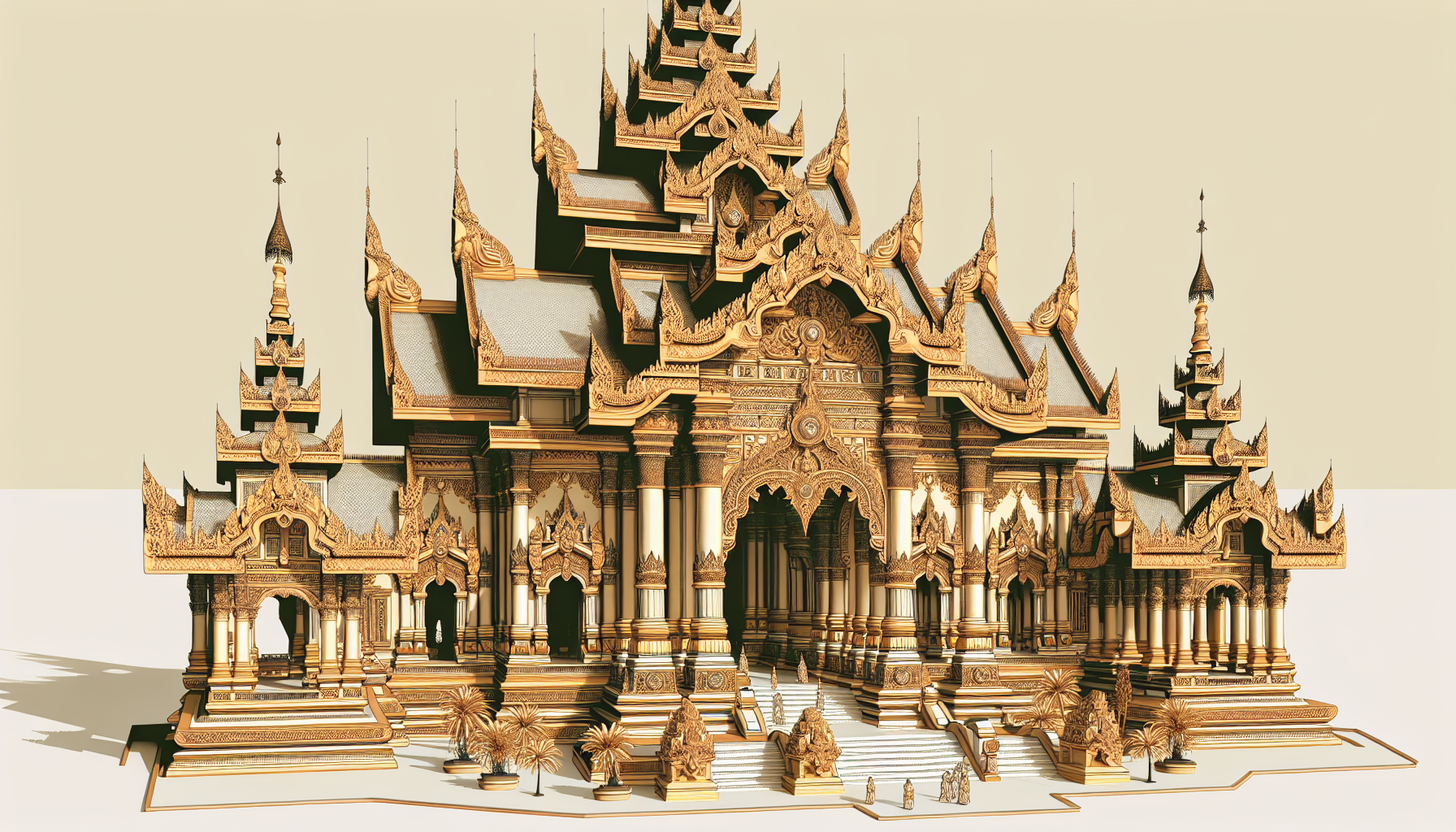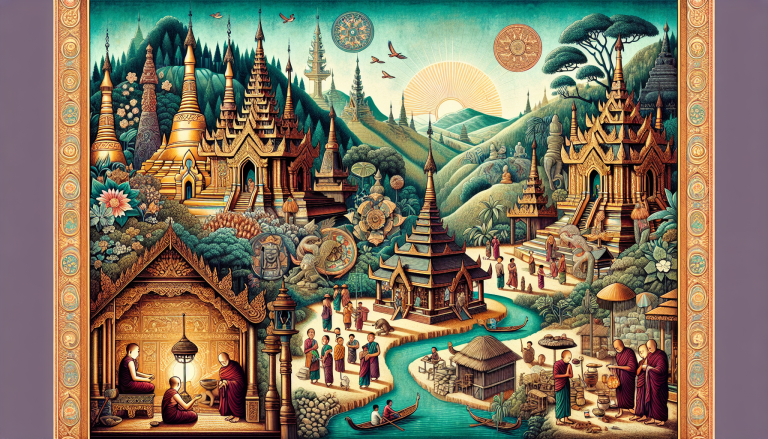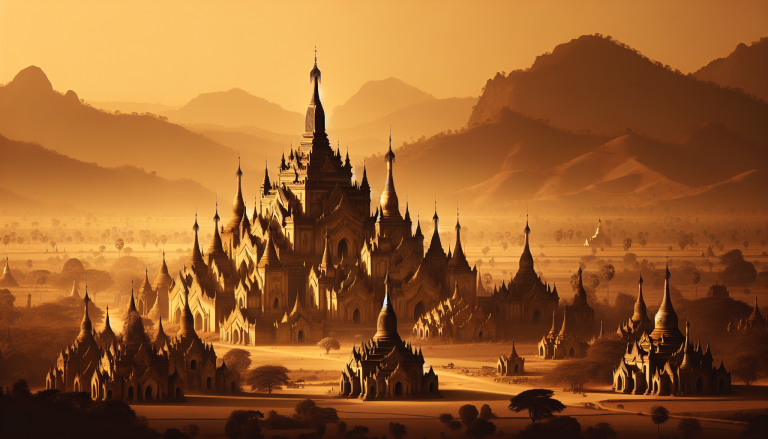Marvels of the Past: Exploring Myanmars Ancient Architectural Wonders
Discover Myanmar’s ancient architecture! Explore Bagan’s temples, Mandalay’s palaces, and timeless traditions.

Ancient Architecture in Myanmar
Myanmar’s ancient architecture offers a fascinating glimpse into its rich cultural and historical tapestry. The influence of Indian architecture and the unique Pyu period stupas are prominent features in the country’s architectural heritage.
Influence of Indian Architecture
The architecture of Myanmar is profoundly influenced by ancient Indian architecture, a connection that dates back to the country’s earliest known inhabitants (Wikipedia). The Mon and Pyu people, the first influential groups to migrate to Myanmar, brought with them Theravada Buddhism, which significantly shaped their architectural creations.
One of the most noticeable influences of Indian architecture in Myanmar is the use of stupas, a type of Buddhist structure that often holds religious relics. These stupas are typically characterized by their cylindrical shape and can be traced back to Indian counterparts. The early stupas in Myanmar adopted elements such as dome-shaped mounds and elaborate gateways, echoing the architectural style of ancient Indian stupas.
| Feature | Indian Influence |
|---|---|
| Stupas | Dome-shaped mounds, elaborate gateways |
| Temples | Intricate carvings, tiered roofs |
Pyu Period Stupas
During the Pyu period, Myanmar saw the construction of cylindrical stupas with distinctive architectural features. These stupas often had four archways and were sometimes used for burial purposes. The Pyu people were instrumental in integrating local and imported styles, resulting in unique contributions to Myanmar’s architectural landscape.
The Pyu period, which spanned from around the 2nd to the 9th century, was marked by the establishment of several city-states. The most notable among them was the city of Sri Ksetra, where many of these ancient stupas were built. These structures were pivotal in the spread of Buddhism in the region. The influence of Pyu architecture can still be seen in the later development of Burmese architectural styles.
To explore more about how the ancient Pyu civilization contributed to the architectural heritage of Myanmar, visit our section on ancient Myanmar civilizations.
| Stupa Type | Features | Period |
|---|---|---|
| Pyu Period Stupas | Cylindrical, four archways | 2nd to 9th century |
Understanding the deep-seated connections between Myanmar and Indian architecture helps you appreciate the intricate designs and historical significance of structures that stand today. For further insights into the timeline of burmese history and the overarching myanmar history and culture, dive into our dedicated sections.
Bagan: Center of Buddhist Architecture
Bagan, the ancient city in Myanmar, was a significant religious and cultural center from the 9th to the 13th centuries. Known for its remarkable Buddhist architecture, Bagan contains over 10,000 red brick stupas and pagodas, making it one of Myanmar’s most important pilgrimage sites (Wikipedia).
Temples and Stupas in Bagan
At the height of Bagan’s history, over 10,000 temples and 1,000 stupas adorned the city (A Little Adrift). These structures served not only as places of worship but also as centers for education and community gatherings. Many of the holiest temples have been reconstructed for modern use, continuing to function as places of worship.
| Structure Type | Number During Height of Bagan |
|---|---|
| Temples | Over 10,000 |
| Stupas | About 1,000 |
Visit our page on historical sites in Myanmar to explore more about these fascinating structures.
Architectural Features of Bagan
The architectural features of Bagan are distinguished by their intricate designs and spiritual significance. Key elements include:
- Thick Red Brick Walls: Many of Bagan’s stupas and temples are built primarily from red bricks, giving them a distinctive appearance.
- Terraced Levels: Temples often exhibit multiple terraced levels, each serving different ceremonial purposes.
- Gilded Spires: Topped with gilded spires, these structures reach toward the sky, symbolizing a connection to the divine.
- Mural Paintings and Carvings: The interiors are typically adorned with mural paintings and intricate carvings that depict Jataka tales, Buddha’s life stories, and other religious themes.
When visiting Bagan, it’s essential to appreciate these unique characteristics that set its architectural wonders apart from other ancient cities. If you want to dive deeper into ancient burmese dynasties or learn more about the Bagan kingdom history, check out our detailed articles.
Bagan’s rich history and its impressive array of religious architectures make it an enthralling destination for travelers interested in history and culture. Whether exploring the massive temples or examining the delicate carvings, you’re sure to be captivated by the marvels of Bagan’s ancient past. For more insights into Myanmar’s architectural heritage, visit our section on myanmar ancient architecture.
Mandalay Palace Architecture
The Mandalay Palace in Myanmar, a stunning example of 19th-century Burmese architecture, stands as a beacon of the nation’s rich cultural heritage. Its design elements reveal the ingenuity and artistic prowess of the ancient Myanmars.
Wooden Structures and Stucco
As you wander through the palace, you’ll notice the extensive use of wood, an integral component of traditional Burmese architecture. The palace, surrounded by walls and a moat, showcases elaborate tiered roofs known as “pyatthat” (Wikipedia). These multi-tiered roofs are quintessentially Burmese, representing the various levels of heaven in Buddhist cosmology.
Another key aspect of the palace’s design is its stucco ornamentation. Stucco work, which was introduced during the Bagan period, is deeply rooted in Mon heritage and adds intricate detail to the palace’s facades (Wikipedia). The skillful application of stucco can be observed in the elaborate floral patterns and mythical creatures adorning the walls.
| Material | Features |
|---|---|
| Wood | Pyatthat (multi-tiered roofs), intricate carvings |
| Stucco | Floral patterns, mythical creatures |
Influence and Design Elements
The design elements of Mandalay Palace draw heavy influence from earlier periods, particularly the Pyu period. The architectural features are enriched with symbolic carvings and decorations based on the Jataka Tales, which are stories about the previous lives of the Buddha.
One striking feature you might appreciate is the intricate wood carvings. These carvings are more than mere decoration; they are a testament to the exceptional craftsmanship and artistic traditions passed down through generations. Each carving tells a story, bringing to life the cultural narratives that have shaped Myanmar’s history.
| Design Element | Influences and Features |
|---|---|
| Pyatthat | Represents levels of heaven in Buddhism |
| Wood Carvings | Stories from the Jataka Tales, traditional art |
| Moat and Walls | Defensive architecture, symbolic separation |
To explore more about the historical context surrounding Mandalay Palace, consider delving into articles on the Burmese history timeline and ancient Myanmar civilizations.
The Mandalay Palace is more than just a royal residence; it’s a living museum of Myanmar’s architectural heritage. For a deeper understanding of how these traditions have been preserved through time, read about the preservation of stucco and wood carving in Burmese practices.
Explore more about the historical influences that shaped this majestic palace in our detailed article on Myanmar historical research.
Preservation of Burmese Architectural Traditions
Preserving the rich history of Myanmar’s ancient architecture is essential in maintaining its cultural heritage. This section delves into traditional methods and the ongoing challenges faced in the maintenance of Burmese architectural wonders.
Stucco and Wood Carving
Stucco and wood carving are integral aspects of traditional Burmese architecture. Stucco work, introduced during the Bagan period, is closely linked to Mon heritage and can be seen in numerous temples and stupas throughout Myanmar (Wikipedia). The intricate designs and patterns crafted from stucco add a unique decorative element to the architecture, often depicting religious themes and cultural stories.
Wood carving, another prominent feature, showcases the exceptional skills passed down through generations. This art form is evident in the intricate details of wooden monasteries, royal palaces, and other significant structures. The carvings often include depictions of mythical creatures, floral patterns, and scenes from the Jataka tales, reflecting the deep-rooted influence of Theravada Buddhism in Burmese culture.
| Architectural Elements | Materials | Techniques |
|---|---|---|
| Stucco | Lime, Sand, Water | Hand-carved designs and patterns |
| Wood Carving | Teak, Hardwood | Intricate hand-carving, Chiseling |
Maintenance Challenges and Practices
Maintaining the grandeur of Burmese architectural traditions amidst the challenges posed by time, climate, and human activity is a daunting task. Several factors contribute to the complexities involved in preservation:
- Climate: The tropical climate of Myanmar, characterized by high humidity and frequent rainfall, poses a significant threat to wooden structures. Wood, being organic, is susceptible to decay and termite infestation. Regular inspections and treatments are essential to prevent deterioration.
- Material Degradation: Stucco works, though durable, can suffer from cracking and erosion over time. Proper restoration methods involve careful cleaning, patching, and sometimes complete reconstruction to preserve the original integrity of the designs.
- Human Activity: Increased tourism and urbanization can lead to wear and tear of ancient structures. Implementing controlled access and ensuring respectful interaction with these historical sites are crucial for their preservation.
Preservation practices include not only physical restoration but also documentation and education. Efforts are made to train local artisans in traditional methods, ensuring that the skills necessary for maintaining these architectural treasures are passed down. Collaboration with international organizations also aids in employing modern conservation techniques while respecting historical authenticity.
For more insights into the preservation of ancient structures and ongoing efforts, you can explore our articles on myanmar ancient ruins and historical sites in Myanmar.
| Challenge | Practice |
|---|---|
| Climate Effects | Regular inspections, treatments, climate control |
| Material Degradation | Careful restoration, use of traditional materials |
| Human Activity | Controlled access, visitor education |
Understanding and addressing these challenges ensures that future generations can continue to appreciate the marvels of Myanmar’s ancient architecture. Discover more about the fascinating myanmar ancient culture and the architectural feats that define it.
By preserving stucco and wood carving traditions, Myanmar continues to honor its vibrant history, while navigating the complexities of modern preservation methods. Engage with more about the mingalabar history and the pyu civilization in Myanmar to deepen your appreciation of this rich heritage.






